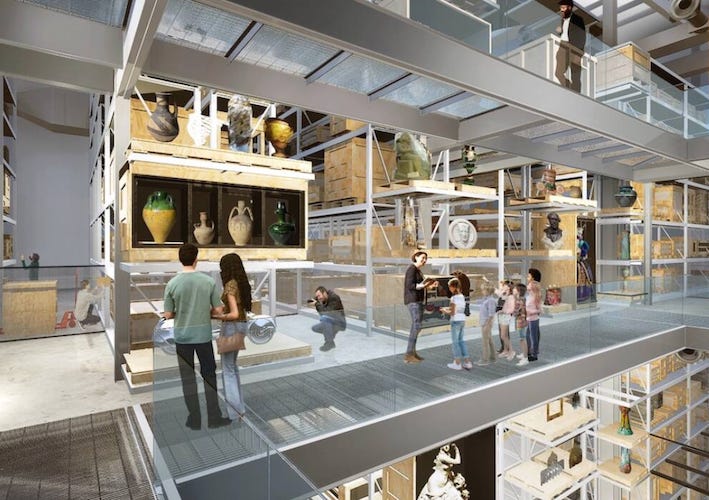A preview of the V&A East Storehouse
The first of two new V&A venues being established on the Queen Elizabeth Olympic Park aims to break new ground in providing public access to museum collections
This article also appears at OnLondon.co.uk, my multi-contributor journalism website about the UK capital which paid subscribers to this personal Substack help fund. If you aren’t one of those already and don’t support OnLondon through a different channel, why not start today? In return, you will get things for your money that other people won’t. Thank you. Dave.
Over ten years in the planning and due to open next May, the V&A East Storehouse promises “unprecedented access” to the famous London museum’s “behind-the-scenes world” with daily opportunities for the public to explore what used to be called its reserve collection in a bespoke space on the Queen Elizabeth Olympic Park (QEOP). What will it be like there? How will it all work?
Yesterday, On London was among those given a preview of the Storehouse, which has been constructed within one end of what served as the International Broadcast Centre during London 2012, the larger of the two buildings that made up the Games-time media centre. These were later transformed into the technology and innovation hub Here East, which stands next to the Lee Navigation Canal in Hackney Wick.
Designed by New York-based architects Diller Scofidio + Renfro, whose back catalogue includes the High Line, the Storehouse already accommodates the over 250,000 objects, 350,000 library books and nearly 1,000 archives that were previously kept, along with collections belonging to other illustrious London museums, at the government-owned Blythe House in West Kensington, close to the original Victoria and Albert Museum. In 2015, it was announced that Blythe House would be sold. From that decision, cutting a long story short, the Storehouse idea flowed.
The V&A was already committed to founding a new museum on the QEOP as part of the emerging East Bank culture and education cluster at Stratford Waterfront. That new V&A East Museum, already standing alongside the new London College of Fashion building, the new BBC Music Studios and the new Sadler’s Wells East, will open its doors in spring 2026. Needing a new home for the vast part of its collection not on display at South Ken, the V&A conceived the Storehouse to make more of it easy to the public to enjoy.
Inside, steps lead up from a reception space to a wide, enclosed platform surrounded by floor-to-ceiling silver metal storage structures, at this stage semi-populated by cabinets, chairs and other items of furniture, some in partial states of packaging undress, others in their naked glory. A glass section of the platform floor allows a view from above of the Agra Colonnade, a 17th Century marble marvel that once fronted a bathhouse. Higher up, two gantries serve the higher levels. The public will be allowed on those too. From next September, the David Bowie Archive, a huge past V&A hit, will be showcased up above.
Essentially, the Storehouse, in its layout and ethos, will extend to the general population an invitation previously bestowed more selectively on such as academics and historians wishing to peruse items of particular interest to them. It will be open seven days a week for anyone to drop in, mooch around, enjoy what they can see. If they wish to look closer or learn more, they will be able to seek and receive assistance from a member of staff. Visits can also be planned using an “order an object service”, making appointments with items of your choice bookable online.
Great stress is being placed on reaching out to potential audiences who might not be habitual visitors to even conventional museums, and on drawing local people in. Neighbourhood schools and creatives have been engaged with. A representative of Newham Council paid careful attention as Gus Casely-Hayford, inaugural director of the two V&A East ventures, explained patiently to On London how Storehouse theory would be put into practice.
Shelves and ledges currently empty will be filled. Other large attractions will include the 1930s Kaufmann Office, the only entire Frank Lloyd Wright interior not kept in the US, a complete Frankfurt Kitchen and, to get adjacent to east London history, a fragment of Robin Hood Gardens, an archetypal “streets in the sky” housing estate built by the Greater London Council in the 1960s, which conservationists have fought a losing battle to save from demolition.
Tim Reeve, the V&A’s deputy director and chief operating officer, who has been leading the museum’s two-track journey to the east, reminded those present that East Bank, whose board he chairs, had originally been conceived during the mayoralty of Boris Johnson. He had backed it enthusiastically under the name “Olympicopolis” – a homage to Albertopolis, the nickname given to the cluster of illustrious cultural and educational institutions on and around Exhibition Road established in Victorian times and integral to the west of the capital today. Under Sadiq Khan, the Borisese was euthenised and East Bank has edged towards completion.
A few minutes across the park, Reeve described the Storehouse as arising from “a combination of opportunity and necessity” and as aspiring to “creating a new paradigm for access to national collections”. In the east of the city, the legacy of London 2012 continues to unfold.
CGImage from Diller Scofidio + Renfro.



